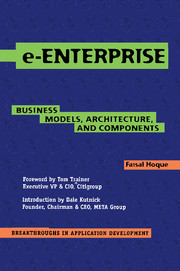Book contents
- Frontmatter
- About the Author
- Contents
- Dedication
- Foreword
- Acknowledgments
- Introduction
- PART 1 The e-Enterprise
- PART 2 Business and Application Models
- Chapter 2 e-Application Models
- Chapter 3 B-to-C e-Application Models
- Chapter 4 B-to-B e-Application Models
- PART 3 e-Enterprise Methodology and Architecture
- PART 4 Enabling Components
- Afterword: Who Will Be the Great e-Enterprises?
- References
- Index
Chapter 3 - B-to-C e-Application Models
Published online by Cambridge University Press: 20 May 2010
- Frontmatter
- About the Author
- Contents
- Dedication
- Foreword
- Acknowledgments
- Introduction
- PART 1 The e-Enterprise
- PART 2 Business and Application Models
- Chapter 2 e-Application Models
- Chapter 3 B-to-C e-Application Models
- Chapter 4 B-to-B e-Application Models
- PART 3 e-Enterprise Methodology and Architecture
- PART 4 Enabling Components
- Afterword: Who Will Be the Great e-Enterprises?
- References
- Index
Summary
The whole concept behind virtual integration is to use direct connections, enhanced by technologies like the Internet, to bring your customers virtually inside your business so you can meet their needs faster and more efficiently than anyone else.
—Michael Dell, Chairman and CEO, Dell Computer Corp.The early stage of transactional e-Applications, which have focused on marketing and selling goods and services to the consumer and have created new distribution and global reach, is giving way to the e-Enterprise model. To understand the fundamentals of e-Enterprise, we must first go back to further analyze the early stages of B-to-C e-Applications, which many people refer to as “.com mania”. In this chapter, I will focus on explaining the different types of B-to-C business models and e-Applications that have prevailed, and I'll discuss the critical success factors associated with them.
Although some of the case studies presented may seem obvious, it is necessary to begin with an intentionally basic analysis of these models and e-Applications in order to compare and contrast them with the B-to-B discussion that will follow in Chapter 4. In this way, we will start to see the distinction between the business models and applications. A key strength of the Net is its ability to treat every customer like she is the only one that matters. Nowhere is this more apparent—or important—than in the B-to-C retail environment.
- Type
- Chapter
- Information
- e-EnterpriseBusiness Models, Architecture, and Components, pp. 57 - 88Publisher: Cambridge University PressPrint publication year: 2000

